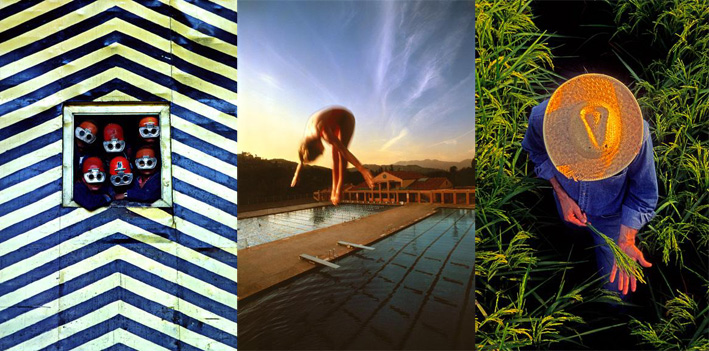Stretching Your Frame of Mind
Stretching Your Frame of Mind
05MIND23 LS1

Take Lesson
05MIND23 LS2

Take Lesson
05MIND23 LS3

Take Lesson
05MIND23 LS4

Take Lesson
 THE ARTIST’S PALETTE: Imagine yourself standing at some location with an artist’s palette in your hand. A recently stretched canvas is waiting on an easel, and a jar full of cleaned brushes sits on a small table next to you. Cobalt and Ultramarine Blue, Raw Sienna and Burnt Umber are positioned side by side while Chromium Oxide Green, Cadmium Red and Yellow lie together opposite them; Mars Black and Titanium White sit in the middle. They all have been squeezed from tubes and anxious to be mixed together.
THE ARTIST’S PALETTE: Imagine yourself standing at some location with an artist’s palette in your hand. A recently stretched canvas is waiting on an easel, and a jar full of cleaned brushes sits on a small table next to you. Cobalt and Ultramarine Blue, Raw Sienna and Burnt Umber are positioned side by side while Chromium Oxide Green, Cadmium Red and Yellow lie together opposite them; Mars Black and Titanium White sit in the middle. They all have been squeezed from tubes and anxious to be mixed together.
Now, imagine that instead of all those wonderful pigments on your palette, there are the ‘elements of design and composition’. Terms like: Vanishing Point, Negative Space, Perspective, Tension, Color, Texture, Pattern, Light and Line, have been etched into the aged wood.
Everyone knows what happens when you mix red and blue, right? You get purple. How about when you mix blue and yellow together? Green, right again. But, what happens when you add Tension, a few Patterns, and Perspective together while taking your daughter’s portrait during an outdoor birthday party? Or Negative Space, some Texture, and a Vanishing Point when you’re composing a street scene in a small Tuscan village? Well, you’ll get the picture.
Remember you’re still an artist, but a camera on a tripod has now replaced the stretched canvas and easel. Through examples of my own work, I’ll help you develop your ‘eye’ by showing you how to incorporate these ‘elements of design and composition’ into your imagery. A new, finely tuned vision will be the result, and you will walk away armed with the ability to create powerful and memorable photographs.
CHASING THE LIGHT: With assignments and exercises to heighten your awareness of shooting during ‘the golden hour’ (early morning and late afternoon), you will gain a better understanding and sensitivity to light, as it enhances every aspect of these important ‘elements of design’. The differences between backlight, side and front light will be studied, and last, learning to use the ‘angle of reflection’ in directing the light source to the subject will soon be an integral part of your visual thought process.
With computer software, I’ll show you how to determine exactly where the sun will be anywhere on the planet from the moment it comes up at sunrise to the instant it sets; and where the shadows will fall days or even months before an important family outing, a personal trip, upcoming wedding, or commercial shoot.
SEEING PAST FIRST IMPRESSIONS: Photographers tend to come across a location or a subject and take the first picture that they see, then move on leaving a lot still on the table. During week four, the class will look at what I call the ‘Master Shot’. This is the first idea that pops into your thought process, and a photograph you could live with in case it started to rain on your parade.
After taking this shot and putting it safely ‘in the can’, I will show you how to look for better ways to visually say the same thing or tell the same story. Getting up close and personal, looking at it from way down low then way up high, changing lenses, adding or subtracting props, and putting in or taking out people. Then, you’ll look at it from various ‘points of view’ while constantly keeping in mind the direction of the light.
What’s important about the Master Shot, and the following images is that while you’re shooting you’ll be learning the difference between one of my favorite expressions; taking a picture and making a picture.

My work can be viewed at: www.joebaraban.com

In order to take my classes you need to use a digital SLR camera where the aspect ration can be set on 3:2, has a good working knowledge of your camera, and be able to shoot on the manual setting.
 After receiving his BA in Journalism, Joe ventured out into the freelance world and never looked back. For the past forty years, Joe has shot professionally for clients from Coca Cola to Hennessy, Cessna to United Air Lines and Boeing, and from Microsoft to IBM and HP. He has shot the full line car brochures for Acura, Saturn, and Range Rover, not to mention campaigns for Acura, Jaguar, Mazda and Ford. The tourism departments for Alberta, Canada, Pennsylvania, Alabama, and Texas have contracted Joe to shoot images for their state campaigns. Just to name a few.
After receiving his BA in Journalism, Joe ventured out into the freelance world and never looked back. For the past forty years, Joe has shot professionally for clients from Coca Cola to Hennessy, Cessna to United Air Lines and Boeing, and from Microsoft to IBM and HP. He has shot the full line car brochures for Acura, Saturn, and Range Rover, not to mention campaigns for Acura, Jaguar, Mazda and Ford. The tourism departments for Alberta, Canada, Pennsylvania, Alabama, and Texas have contracted Joe to shoot images for their state campaigns. Just to name a few.
Joe spent his early years shooting for AP, UPI, and was a Black Star photographer. Over the years, National Geographic, Life, Texas Monthly, Time, Geo, Newsweek, and the New York Times Magazine have used Joe for several of their editorial assignments.
Teaching people how to use their eye has always been one of Joe’s passions, and he’s conducted his personal workshops around the world and also with organizations including: The Maine Media Workshop (twenty-seven years), The Santa Fe Workshop, The Julia Dean Workshop in Hollywood, The South Florida Workshop, The Pacific Northwest School of Art on Whidbey Island, The Texas Photographic Workshop, Objectif’s, a photographic organization in Singapore, and The Houston Center for Photography. Joe has also conducted continuing education classes at Rice University.
Joe in conjunction with the Santa Fe Workshops and Epic Photo Tours, is now leading workshops to Cuba, Myanmar, and Viet Nam.
He has been sought out as a guest speaker for various ASMP chapters (American Society of Media Photographers), advertising and art director’s clubs across the country, The Art Center in Pasadena, California, and Brooks Institute. He has given seminars at Photo East in New York, Photo West in San Francisco, and Viacom (the national photographic convention in Canada).
Joe has had feature articles written about his work in Communication Arts Magazine, Photo District News, Japan’s Portfolio Magazine, and Studio Magazine. His work has appeared in CA, Photo Graphis, and The Mead Annual Report Show. His expertise had also spurred an invitation to judge the prestigious Communication Arts Photography Annual.
He currently has four of his Fine Art photographs in the permanent photography collection at the Museum of Fine Arts in Houston, headed by world acclaimed photography curator Ann Tucker.

